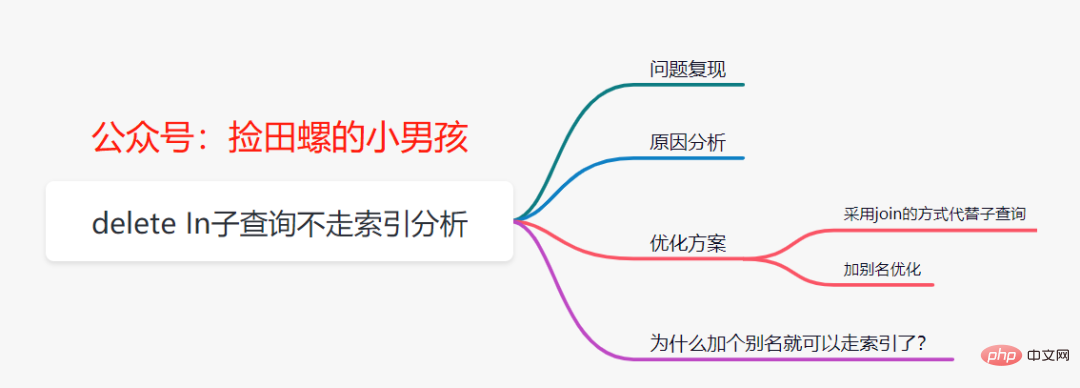 Database
Database
 Mysql Tutorial
Mysql Tutorial
 Analysis of the problem that delete in subquery does not go to the index in mysql
Analysis of the problem that delete in subquery does not go to the index in mysql
Analysis of the problem that delete in subquery does not go to the index in mysql
Recommended learning: mysql video tutorial
Before the article begins, let me ask you a question: delete in subquery , will it be indexed?? The first impression of many partners is that they know how to index. Recently we had a production problem related to it. This article will discuss this issue with everyone and attach an optimization plan.
 Problem Reproduction
Problem Reproduction
MySQL version is
5.7, assuming there are currently two tables account and old_account, the table structure is as follows: <div class="code" style="position:relative; padding:0px; margin:0px;"><pre class='brush:php;toolbar:false;'>CREATE TABLE `old_account` (
`id` int(11) NOT NULL AUTO_INCREMENT COMMENT &#39;主键Id&#39;,
`name` varchar(255) DEFAULT NULL COMMENT &#39;账户名&#39;,
`balance` int(11) DEFAULT NULL COMMENT &#39;余额&#39;,
`create_time` datetime NOT NULL COMMENT &#39;创建时间&#39;,
`update_time` datetime NOT NULL ON UPDATE CURRENT_TIMESTAMP COMMENT &#39;更新时间&#39;,
PRIMARY KEY (`id`),
KEY `idx_name` (`name`) USING BTREE
) ENGINE=InnoDB AUTO_INCREMENT=1570068 DEFAULT CHARSET=utf8 ROW_FORMAT=REDUNDANT COMMENT=&#39;老的账户表&#39;;
CREATE TABLE `account` (
`id` int(11) NOT NULL AUTO_INCREMENT COMMENT &#39;主键Id&#39;,
`name` varchar(255) DEFAULT NULL COMMENT &#39;账户名&#39;,
`balance` int(11) DEFAULT NULL COMMENT &#39;余额&#39;,
`create_time` datetime NOT NULL COMMENT &#39;创建时间&#39;,
`update_time` datetime NOT NULL ON UPDATE CURRENT_TIMESTAMP COMMENT &#39;更新时间&#39;,
PRIMARY KEY (`id`),
KEY `idx_name` (`name`) USING BTREE
) ENGINE=InnoDB AUTO_INCREMENT=1570068 DEFAULT CHARSET=utf8 ROW_FORMAT=REDUNDANT COMMENT=&#39;账户表&#39;;</pre><div class="contentsignin">Copy after login</div></div>The executed SQL is as follows:
delete from account where name in (select name from old_account);
Let’s explain the execution plan,
 From the
From the
results, we can find: firstscan the whole table account, and then execute the subquery row by row to determine whether the conditions are met; obviously, this execution plan and We expected it not to match, because did not go to index . But if
is replaced with select, the index will be used. As follows:
 Why does the
Why does the
subquery go through the index, but the delete in subquery does not go through the index? Cause Analysis
What is the difference between the select in subquery statement and the delete in subquery statement? Let’s execute the following SQL to see
explain select * from account where name in (select name from old_account); show WARNINGS;
show WARNINGSselect `test2`.`account`.`id` AS `id`,`test2`.`account`.`name` AS `name`,`test2`.`account` .`balance` AS `balance`,`test2`.`account`.`create_time` AS `create_time`,`test2`.`account`.`update_time` AS `update_time` from `test2`.`account`You can view the final executed sql after optimization
The results are as follows :
semi join (`test2`.`old_account`)select in subquerywhere (`test2`.`account`.`name` = `test2`.`old_account`.`name`)
It can be found that during actual execution, MySQL optimized the
and changed the subquery to a join method, so the index can be used. But unfortunately, MySQL did not optimize it for delete in subquery. Optimization plan
So how to optimize this problem? Through the above analysis, it is obvious that the delete in subquery can be changed to
join. After we change to the join method, let's explain again:
 #We can find that the change to the join method is
#We can find that the change to the join method is
In fact, for update or delete subquery statements, MySQL official website
also recommends join method optimizationIn fact, Adding an alias to the table can also solve this problem, as follows: 
explain delete a from account as a where a.name in (select name from old_account)
Why can adding an alias enable indexing? 
what
? Why is it possible to add an alias, delete in subquery, and use the index again?Let’s go back and look at explain’s execution plan. We can find that in the Extra column, there is LooseScan
.
 What is LooseScan?
What is LooseScan?
semi join subquery. Because the subquery is changed to join, the delete in subquery can be indexed; If you add an alias
, it will use theLooseScan strategy, and the LooseScan strategy is essentially It is an execution strategy of semi join subquery. Therefore, adding an alias allows the delete in subquery to be indexed!
Recommended learning:mysql video tutorial
The above is the detailed content of Analysis of the problem that delete in subquery does not go to the index in mysql. For more information, please follow other related articles on the PHP Chinese website!

Hot AI Tools

Undresser.AI Undress
AI-powered app for creating realistic nude photos

AI Clothes Remover
Online AI tool for removing clothes from photos.

Undress AI Tool
Undress images for free

Clothoff.io
AI clothes remover

Video Face Swap
Swap faces in any video effortlessly with our completely free AI face swap tool!

Hot Article

Hot Tools

Notepad++7.3.1
Easy-to-use and free code editor

SublimeText3 Chinese version
Chinese version, very easy to use

Zend Studio 13.0.1
Powerful PHP integrated development environment

Dreamweaver CS6
Visual web development tools

SublimeText3 Mac version
God-level code editing software (SublimeText3)

Hot Topics
 MySQL: An Introduction to the World's Most Popular Database
Apr 12, 2025 am 12:18 AM
MySQL: An Introduction to the World's Most Popular Database
Apr 12, 2025 am 12:18 AM
MySQL is an open source relational database management system, mainly used to store and retrieve data quickly and reliably. Its working principle includes client requests, query resolution, execution of queries and return results. Examples of usage include creating tables, inserting and querying data, and advanced features such as JOIN operations. Common errors involve SQL syntax, data types, and permissions, and optimization suggestions include the use of indexes, optimized queries, and partitioning of tables.
 MySQL's Place: Databases and Programming
Apr 13, 2025 am 12:18 AM
MySQL's Place: Databases and Programming
Apr 13, 2025 am 12:18 AM
MySQL's position in databases and programming is very important. It is an open source relational database management system that is widely used in various application scenarios. 1) MySQL provides efficient data storage, organization and retrieval functions, supporting Web, mobile and enterprise-level systems. 2) It uses a client-server architecture, supports multiple storage engines and index optimization. 3) Basic usages include creating tables and inserting data, and advanced usages involve multi-table JOINs and complex queries. 4) Frequently asked questions such as SQL syntax errors and performance issues can be debugged through the EXPLAIN command and slow query log. 5) Performance optimization methods include rational use of indexes, optimized query and use of caches. Best practices include using transactions and PreparedStatemen
 How to connect to the database of apache
Apr 13, 2025 pm 01:03 PM
How to connect to the database of apache
Apr 13, 2025 pm 01:03 PM
Apache connects to a database requires the following steps: Install the database driver. Configure the web.xml file to create a connection pool. Create a JDBC data source and specify the connection settings. Use the JDBC API to access the database from Java code, including getting connections, creating statements, binding parameters, executing queries or updates, and processing results.
 Why Use MySQL? Benefits and Advantages
Apr 12, 2025 am 12:17 AM
Why Use MySQL? Benefits and Advantages
Apr 12, 2025 am 12:17 AM
MySQL is chosen for its performance, reliability, ease of use, and community support. 1.MySQL provides efficient data storage and retrieval functions, supporting multiple data types and advanced query operations. 2. Adopt client-server architecture and multiple storage engines to support transaction and query optimization. 3. Easy to use, supports a variety of operating systems and programming languages. 4. Have strong community support and provide rich resources and solutions.
 How to start mysql by docker
Apr 15, 2025 pm 12:09 PM
How to start mysql by docker
Apr 15, 2025 pm 12:09 PM
The process of starting MySQL in Docker consists of the following steps: Pull the MySQL image to create and start the container, set the root user password, and map the port verification connection Create the database and the user grants all permissions to the database
 MySQL's Role: Databases in Web Applications
Apr 17, 2025 am 12:23 AM
MySQL's Role: Databases in Web Applications
Apr 17, 2025 am 12:23 AM
The main role of MySQL in web applications is to store and manage data. 1.MySQL efficiently processes user information, product catalogs, transaction records and other data. 2. Through SQL query, developers can extract information from the database to generate dynamic content. 3.MySQL works based on the client-server model to ensure acceptable query speed.
 Laravel Introduction Example
Apr 18, 2025 pm 12:45 PM
Laravel Introduction Example
Apr 18, 2025 pm 12:45 PM
Laravel is a PHP framework for easy building of web applications. It provides a range of powerful features including: Installation: Install the Laravel CLI globally with Composer and create applications in the project directory. Routing: Define the relationship between the URL and the handler in routes/web.php. View: Create a view in resources/views to render the application's interface. Database Integration: Provides out-of-the-box integration with databases such as MySQL and uses migration to create and modify tables. Model and Controller: The model represents the database entity and the controller processes HTTP requests.
 How to install mysql in centos7
Apr 14, 2025 pm 08:30 PM
How to install mysql in centos7
Apr 14, 2025 pm 08:30 PM
The key to installing MySQL elegantly is to add the official MySQL repository. The specific steps are as follows: Download the MySQL official GPG key to prevent phishing attacks. Add MySQL repository file: rpm -Uvh https://dev.mysql.com/get/mysql80-community-release-el7-3.noarch.rpm Update yum repository cache: yum update installation MySQL: yum install mysql-server startup MySQL service: systemctl start mysqld set up booting






